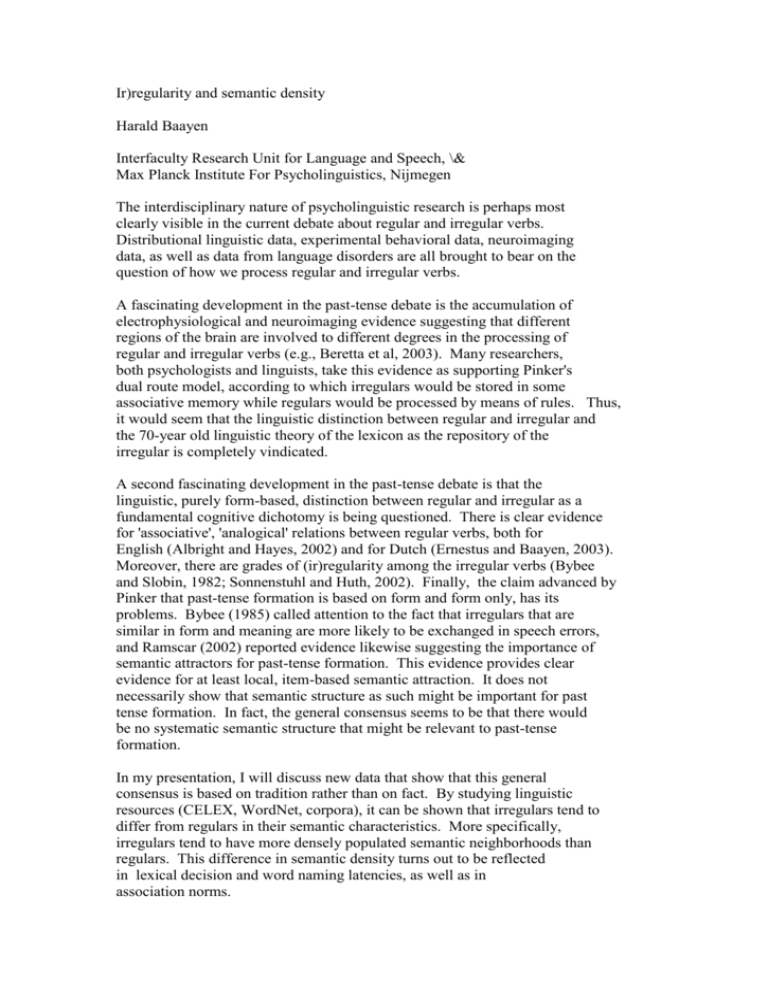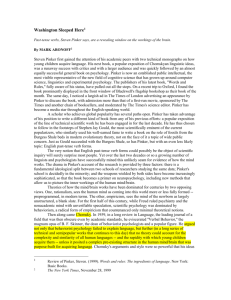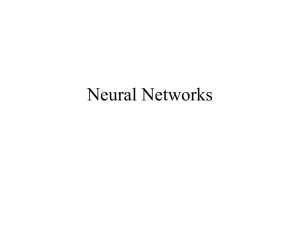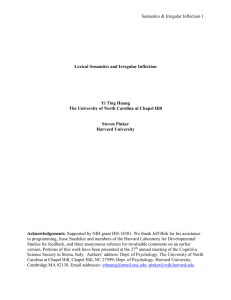Ir)regularity and semantic density
advertisement

Ir)regularity and semantic density Harald Baayen Interfaculty Research Unit for Language and Speech, \& Max Planck Institute For Psycholinguistics, Nijmegen The interdisciplinary nature of psycholinguistic research is perhaps most clearly visible in the current debate about regular and irregular verbs. Distributional linguistic data, experimental behavioral data, neuroimaging data, as well as data from language disorders are all brought to bear on the question of how we process regular and irregular verbs. A fascinating development in the past-tense debate is the accumulation of electrophysiological and neuroimaging evidence suggesting that different regions of the brain are involved to different degrees in the processing of regular and irregular verbs (e.g., Beretta et al, 2003). Many researchers, both psychologists and linguists, take this evidence as supporting Pinker's dual route model, according to which irregulars would be stored in some associative memory while regulars would be processed by means of rules. Thus, it would seem that the linguistic distinction between regular and irregular and the 70-year old linguistic theory of the lexicon as the repository of the irregular is completely vindicated. A second fascinating development in the past-tense debate is that the linguistic, purely form-based, distinction between regular and irregular as a fundamental cognitive dichotomy is being questioned. There is clear evidence for 'associative', 'analogical' relations between regular verbs, both for English (Albright and Hayes, 2002) and for Dutch (Ernestus and Baayen, 2003). Moreover, there are grades of (ir)regularity among the irregular verbs (Bybee and Slobin, 1982; Sonnenstuhl and Huth, 2002). Finally, the claim advanced by Pinker that past-tense formation is based on form and form only, has its problems. Bybee (1985) called attention to the fact that irregulars that are similar in form and meaning are more likely to be exchanged in speech errors, and Ramscar (2002) reported evidence likewise suggesting the importance of semantic attractors for past-tense formation. This evidence provides clear evidence for at least local, item-based semantic attraction. It does not necessarily show that semantic structure as such might be important for past tense formation. In fact, the general consensus seems to be that there would be no systematic semantic structure that might be relevant to past-tense formation. In my presentation, I will discuss new data that show that this general consensus is based on tradition rather than on fact. By studying linguistic resources (CELEX, WordNet, corpora), it can be shown that irregulars tend to differ from regulars in their semantic characteristics. More specifically, irregulars tend to have more densely populated semantic neighborhoods than regulars. This difference in semantic density turns out to be reflected in lexical decision and word naming latencies, as well as in association norms. These results challenge the idea that past tense formation rules would be encapsulated to be sensitive to form only. They explain why semantic attraction effects appear so easily in the WUG task, and they point to a potential semantic contribution of semantics to the dissociation between regulars and irregulars in the neuroimaging data. References Albright, A. and Hayes, B. (2001), Rules vs. Analogy in English Past Tenses: A Computational/Experimental Study. Manuscript UCLA. Balota, D.A., Cortese, M.J., & Pilotti, M. (1999), Item-level analyses of lexical decision performance: Results from a mega-study. In Abstracts of the 40th Annual Meeting of the Psychonomics Society (p. 44). Los Angeles, CA: Psychonomic Society. Beretta, A., Campbell, C., Carr, T.H., Huang, J., Schmitt, L.M., Christianson, K. and Cao, Y. (2003), An ER-fMRIO investigation of morphological inflection in German reveals that the brain makes a distinction between regular and irregular forms. Brain and Language 85, 67-92. Bybee, J. L. (1985), Morphology: A study of the Relation between Meaning and Form, Benjamins, Amsterdam Bybee, J. L. and Slobin, D. I. (1982), Rules and schemas in the development and use of the English past tense, Language, 58, 265-289. Ernestus, M. and Baayen, R. H. (2003), Predicting the unpredictable: Interpreting neutralized segments in Dutch, Language (in press). Pinker, S. (1999), Words and Rules: The Ingredients of Language, Weidenfeld and Nicolson, London. Ramscar, M. (2002), The role of meaning in inflection: Why the past tense doesn't require a rule, Cognitive Psychology, 45, 45-94. Sonnenstuhl, I. and Huth, A. (2002), Processing and representation of German -n plurals: a dual mechanism approach, Brain and Language 81, 276-290.







